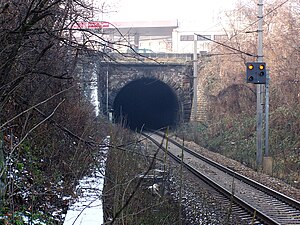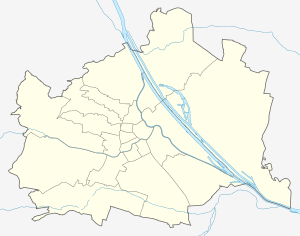Steudel tunnel
| Steudel tunnel | ||
|---|---|---|
|
Eastern portal of the Steudeltunnel (2007)
|
||
| use | Railway tunnel | |
| traffic connection | Connecting track | |
| place | Vienna | |
| length | 283 m | |
| business | ||
| release | 1873 | |
| closure | March 28, 2010 | |
| location | ||
|
|
||
| Coordinates | ||
| East portal | 48 ° 11 ′ 4 " N , 16 ° 22 ′ 31" E | |
| West portal | 48 ° 11 ′ 5 ″ N , 16 ° 22 ′ 19 ″ E | |
The Steudeltunnel in Vienna , opened in 1873, was a 283 m long railway tunnel in the 10th district of Vienna , Favoriten . It was named after the first district head of Favoriten, Johann Heinrich Steudel , as this landowner was in this area. The tunnel was closed on March 28, 2010 and subsequently removed.
- location
The Steudeltunnel was part of the connecting line from the south to the north runway and crossed under the south runway at an oblique angle at Favoritenstrasse and later at Südtiroler Platz . The route then ran on the freight station area of the southern and eastern railways similar to the high-altitude access from the southern railroad to the new central station (see historical map here ), but in one cut.
The tunnel opened in 1873, in the year of the world exhibition in Vienna , replaced the above-ground routing of the connecting railway in this area built in 1857 (for details on the above-ground route see here , last paragraph). It was originally two-pronged.
- Western ramp and tunnel portal
The later single-track line through the tunnel branched off from the south-west tracks between today's S-Bahn stations Matzleinsdorfer Platz (high level) and Vienna Central Station (tracks 1 and 2, low level) with a downward ramp to the northwest. After the construction of the lower-lying main line of the Viennese rapid transit railway near the Südbahnhof in the late 1950s , the western tunnel portal was located directly next to the portal of the tunnel of the S-Bahn main line (at Schönburgstrasse).
- Eastern tunnel portal
The eastern tunnel portal was located immediately after crossing under the Südbahn tracks south of the former Hinteren Südbahnstraße at the corner of Johannitergasse and Sonnwendgasse.
- Further routing
The connecting railway line then ran (although this section of the line had existed for much longer than the Steudeltunnel) eastwards between the new main station and the Gerhard-Bronner-Straße, which was parallel to it to the south, in an incision in which, in the open, low-lying areas that were recorded in the timetable until 1945 Guided stop at Favoriten . Before this stop, a track branched off to the right in the direction of travel to the freight tracks. After the stop, the Arsenal tunnel , which had been closed since the S-Bahn opened in 1962, was connected to the eastern end of the cut under the eastern railway to the connecting railway towards Arsenal and northeast. After this tunnel was closed, a ramp was built here for the passing freight train traffic to the southeast to the main tracks of the Eastern Railway .
- Construction details
The tunnel consisted of a brick vault and a concrete vault that was built on the occasion of the renewal of the railway bridge over Südtiroler Platz after the Second World War. As part of the electrification of the Donauländebahn , the tunnel was also electrified as a diversion route in 1971. The slope of the ramp to the east runway was reduced from 25 ‰ to 12 ‰.
- replacement
In the course of the construction of the new Vienna Central Station, the Steudeltunnel was closed after the completion of a double-track connection in an elevated position, which replaces it, and then removed. When the new tracks were located, it was assumed that all trains passing from the southern runway to the eastern runway, even if they do not stop at the main station, would pass through it. For this purpose, a through track was built between platform tracks 8 and 9 and next to track 12. Since the tunnel was located below the main train station and under the new railway bridge over Laxenburger Straße, for which load-bearing supports should have been placed on the tunnel ceiling, retaining walls were built into the tunnel and the remaining cavity, with the exception of a sewer that had previously been laid, was filled with concrete.
literature
- Karl Uhlik: Rehabilitation of the Steudel tunnel. In: Railway technology. 1973/1, Bohmann Druck und Verlag Ges.mbH & Co. KG, pp. 8-10, ISSN 0013-2829

